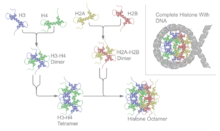核小體
外观
(重定向自核體)
此條目可参照英語維基百科相應條目来扩充。 |


核小體(英語:Nucleosome,也译作核體或核仁小體)是組成真核生物染色質(除精子染色質外)的基本單位。
核小体是由DNA與4對組織蛋白(共8個)组成的複合物,其中有H2A和H2B的二聚體兩組以及H3和H4的二聚體兩組。另外還有一種H1負責連結兩個核小體之間的DNA。
核小體假說是在1974年,由Don Olins、Ada Olins[1]與羅傑·科恩伯格[2][3]等人首次提出的。
参见
[编辑]參考文獻
[编辑]- ^ AL and Olins DE, "Spheroid Chromatin Units (nu Bodies)" (页面存档备份,存于互联网档案馆), Science (1974); 183: 330 - 332
- ^ McDonald D, "Milestone 9, (1973-1974) The nucleosome hypothesis: An alternative string theory", Nature Milestones: Gene Expression. (2005) Dec 1; http://www.nature.com/milestones/geneexpression/milestones/articles/milegene09.html (页面存档备份,存于互联网档案馆)
- ^ Kornberg, RD, "Chromatin structure: a repeating unit of histones and DNA", Science. (1974); 184: 868–871
外部链接
[编辑]- Nucleosomes on the group page of Timothy Richmond
- 蛋白质数据库中有关核小体的资料
- Dynamic Remodeling of Individual Nucleosomes Across a Eukaryotic Genome in Response to Transcriptional Perturbation
- Catalog of servers with experimental data and prediction tools for nucleosome positioning (页面存档备份,存于互联网档案馆)
| 这是一篇與生物学相關的小作品。您可以通过编辑或修订扩充其内容。 |
